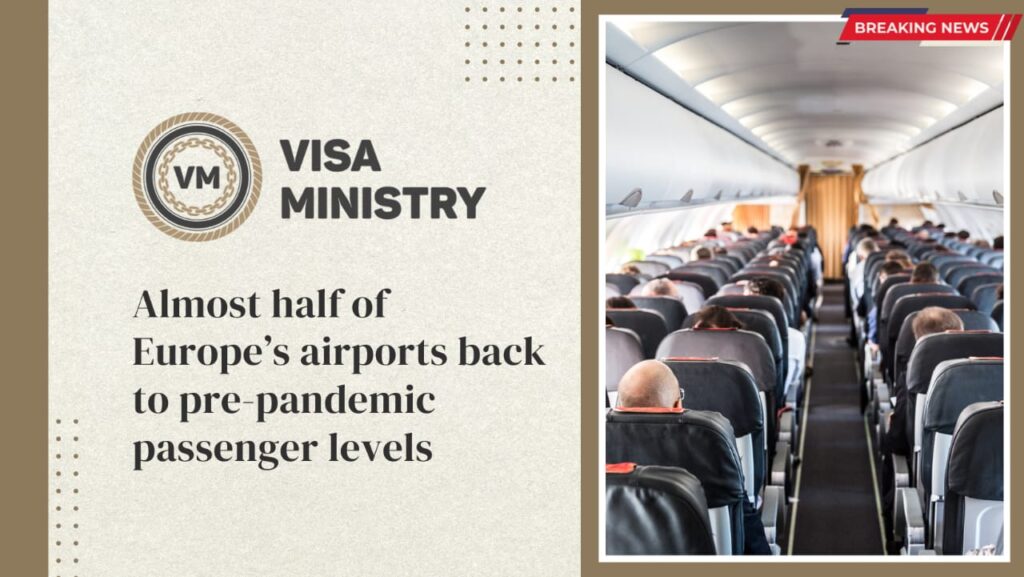Data reveals that by March, 45% of key hubs had reached recovery milestones, although still being negatively impacted by external causes.
BRUXELLES – The European airport industry association ACI Europe published its air traffic report for March 2023 and the entire first quarter of 2023 (Q1). In the first quarter of this year, passenger volume at all of Europe’s airports continued to rise, up +49% from the same time the previous year. Since travel restrictions were being relaxed at that time last year, and passenger traffic had begun to rebound as a result, the rise considerably slowed down in March at +34%.
Just -10.6% less people travelled during the first quarter than they did prior to the epidemic (Q1 2019). Domestic passenger traffic is falling behind (-18.5%), while international passenger traffic continues to drive the recovery and is moving closer to pre-pandemic levels (-9%). This indicates structural market changes brought on by elements such as evolving consumer behaviour and modal shifts.
Up from 40% in February, by the end of March, 45% of Europe’s airports had reached or even surpassed their pre-pandemic levels.
Variations in performance resulting from patterns of recovery and the Ukraine War
Passenger numbers at EU+ airports1 increased by +53.4% in the first quarter compared to the same period in 2017. EU+ passenger traffic was down 11.5% from pre-pandemic (Q1 2019) levels, yet there were notable performance differences. This illustrates a recovery that is still mostly driven by leisure and blending demand, as well as the effects of the conflict in Ukraine and selective capacity increase by Ultra-Low-Cost Carriers:
Portugal (+15.2%), Croatia (+12.1%), Luxembourg (+9.1%), and Cyprus (+8.4%) airports all saw significant increases over pre-pandemic levels.
The airports that were the furthest from a full recovery were those in Slovakia (-44.9%), Slovenia (-41.2%), Germany (-32.2%), the Czech Republic (-29.7%), and Finland (-26.2%).
Aside from the underperformance of German airports, which was also a result of labour unrest, Spain’s airports (+1.7%) had the best results among the main EU+ markets, followed by those in Italy (-6.7%), France (-11.4%), and the UK (-12.9%).
Passenger traffic increased by +30.2% in the first quarter at airports in the rest of Europe2 compared to the same period previous year.
Passenger traffic in the rest of Europe outpaced the EU+ market at merely -6% when compared to pre-pandemic (Q1 2019) levels.
Airports in Ukraine (-100%) have seen a complete loss of passenger traffic for more than a year, whilst those in Russia (+4.5%) were able to maintain pre-pandemic levels of passenger traffic in the first quarter as a result of a shift in passenger demand to domestic and non-EU+ markets. Airports in Uzbekistan (+112.5%), Kazakhstan (+55.1), Armenia (+37.6%), and Serbia (+26.3%) all saw an improvement as a result.
Airports in Albania (+91%) had tremendous development as a result of the capacity used by Ultra-Low-Cost Carriers, whereas those in Turkey’s largest market (-4.9%) were almost fully recovered.
Large and important airports recover more slowly.
Comparing the first quarter of 2019 to the same period in 2018, passenger traffic at the Majors (the top 5 European airports in 20193) increased by +52.4%. Volumes were -11.2% below pre-pandemic levels (Q1 2019) because hub carrier capacity deployment was less extensive and the impact of China’s reopening was still only marginal.
Istanbul (+5.9%) and Madrid (0%), two of the top five airports in Europe today, were the only ones to return to their pre-pandemic levels in the first quarter of 2019.
The busiest airport in Europe is once again London-Heathrow (-5.7%), which is followed by Istanbul, Paris-CDG (-13.2%), Madrid, and Amsterdam-Schiphol (-20.8%).
Frankfurt (-23.3%) and Munich (-30.1%) in Germany considerably underperformed their rivals, with strikes and a reduced penetration of
Low-cost carriers as major causes.
In the meantime, a number of other large5 and capital airports exceeded their pre-pandemic volumes in the first quarter, including Lisbon (+13.9%), Tel Aviv (+14%), Palma de Mallorca (+2.4%), Athens (+2.3%), and Dublin (+1.9%). This was due to the leisure demand’s resilience to inflationary pressures and higher air fares as well as the reliance on Low-Cost Airline traffic.
Low cost bases and a few regionals perform better
Numerous significant Ultra-Low-Cost airport bases, like Beauvais (+34.3%), Bergamo (+19.7%), and Charleroi (+16%), continued to profit from the same recovery patterns and market dynamics.
They also benefited regional and smaller airports6, where first-quarter passenger traffic was just -4.5% lower than pre-pandemic (Q1 2019) levels. They included Kutaisi (+61.4%), Varna (+59.1%), Madeira (+43.5%), Asturias (+36.4%), Memmingen (+40.3%), Trapani (+31.9%), Rotterdam (+26.8%), Lodz (+36.7%), Paphos (+29.1%), and Chania (+20.6%), which served famous tourist destinations and/or relied on low-cost carriers.
Aviation movements
Compared to the same time last year, aircraft movements climbed by +24% in the first quarter across the European airport network, with airports in the EU+ markets seeing +25.1% growth and those in the rest of Europe seeing +18.2% growth.
Airport group data
Airports that receive more than 25 million passengers annually (Group 1), between 10 and 25 million passengers annually (Group 2), between 5 and 10 million passengers annually (Group 3), and less than 5 million passengers annually (Group 4) reported an average adjustment of -12.2%, -11%, -4.3%, and -6.2%, respectively, as compared to pre-pandemic traffic levels during the first quarter of 2019 (Q1 2019).
The following airports recorded the largest increases in passenger traffic during the first quarter of 2023 compared to the first quarter of 2019:
- Group 1 includes Dublin (+1.9%), Lisbon (+13.9%), Istanbul IST (+5.9%), Palma de Mallorca (+2.4%), and Athens (+2.3%).
- Group 2 consists of the following cities: Milan BGY (+19.7%), Tel Aviv (+14%), Catania (+12.6%), Porto (+12.1%), and Naples (+9.2%).
- Group 3 includes Krakow (+15.7%), Sochi (+79.6%), Almaty (+55.1%), Belgrade (+26.9%), and Charleroi (+16.0%).
- Group 4 includes Tirana (+91%), Varna (+59.1%), Madeira (+43.5%), Memmingen (+40.3%), and Yerevan-Zvartnots (+37.6%).
Source: traveldailynews

